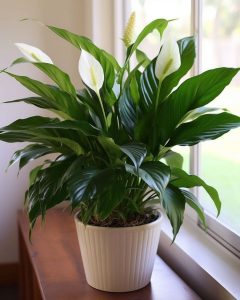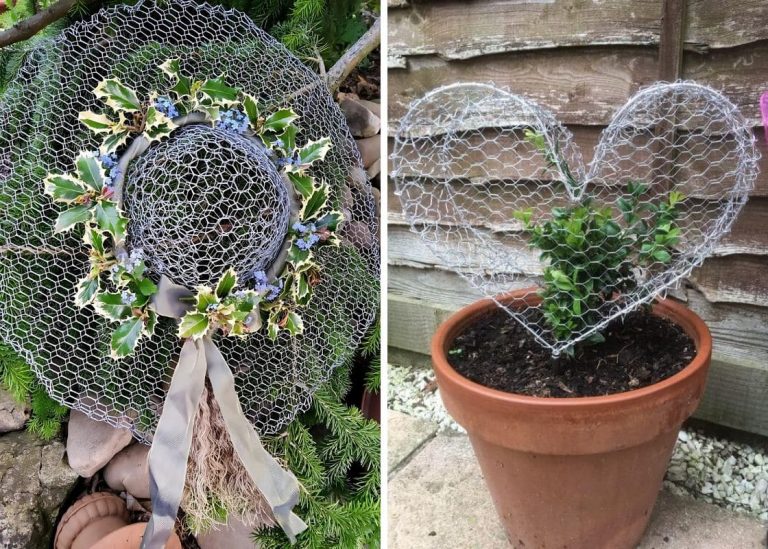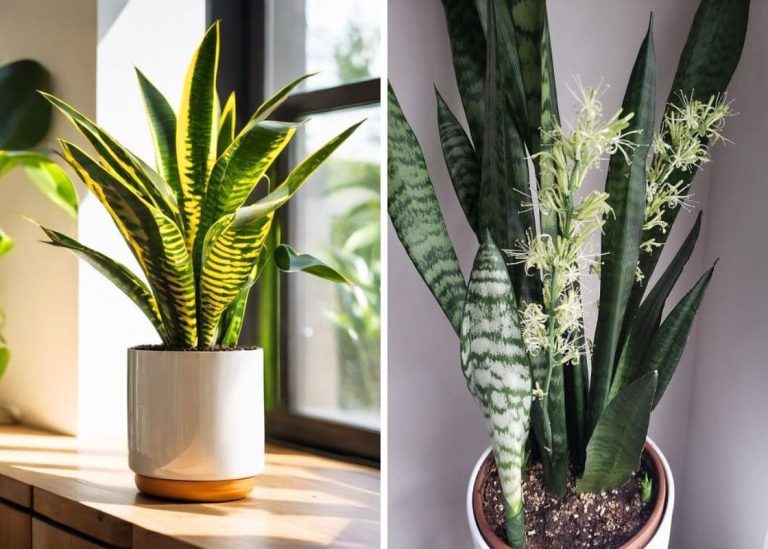8 Pro Tips to Get Your Peace Lily to Bloom More Often
still remember the day I brought home my first peace lily. It sat neatly in a plastic pot, leaves glossy and full, like it had just stepped off a catalog page. I placed it by the window, watered it with care, and waited. And waited. Weeks turned into months, and while the leaves stayed lush, not a single white bloom appeared.
At one point, I whispered to it, “What am I doing wrong?” as if it could answer.
I didn’t give up, but I did confess to a friend at the garden club that I was about to. She smiled and said, “Peace lilies are peaceful. They bloom when they’re content. Your job is to help it feel at home.”
That changed everything.

Over time, I adjusted its light, gave it room to grow, and learned to listen—not with my ears, but by watching its leaves, its posture, even the rhythm of its watering needs. The first bloom came quietly one morning, like a thank-you. I nearly cried.
Since then, I’ve grown several peace lilies, and while none are ever in a hurry, they all eventually offer up their graceful white spathes—some once a year, others twice, depending on how well I care for them.
Here are the lessons I’ve learned—shared with you in case your peace lily is still waiting to bloom.
1. Give It the Right Amount of Light
I used to keep my peace lily in a dim hallway—because I heard it was “low light tolerant.” And yes, it survived. But it never bloomed. Turns out, there’s a difference between surviving and thriving.
Now, I keep mine near an east-facing window with gentle morning light. The light filters through sheer curtains and gives the plant a soft, warm glow—just the way it likes it.
Try this:
-
Place your peace lily in bright, indirect sunlight (morning light is ideal)
-
Avoid harsh midday sun—it can scorch the leaves
-
If your space is dark, supplement with a soft grow light
When it’s happy with the light, the leaves perk up and the plant starts thinking about flowering.

2. Water Consistently, But Not Too Much
Watering was the second thing I got wrong. At first, I followed a strict calendar—every Sunday like clockwork. But peace lilies aren’t on our schedule; they’re on their own. One week it’s dry in five days, the next it takes ten.
Now, I test the soil with my finger. If the top inch is dry, it’s time to water. I pour slowly until water seeps from the bottom, then let it drain. It’s a peaceful ritual—no rush, no rules.
Watering tips:
-
Let the top 1 inch of soil dry before watering
-
Use room-temperature water to avoid shocking the roots
-
Always empty excess water from trays or saucers

You’ll know it’s thirsty when the leaves droop—but don’t wait too long. Repeated wilting stresses the plant and delays blooms.
3. Boost Humidity Around Your Plant
I live in a climate where winters dry out the air so badly, even my lips complain. And my peace lily? It lets me know, too. The leaf tips turn brown, and the blooms stay hidden. Once I started boosting humidity, the whole plant seemed to breathe easier.
Sometimes I group my peace lily with other plants to create a mini jungle. Other times, I set it on a pebble tray filled with water, or mist the air around it in the early morning.
To raise humidity:
-
Set the pot on a shallow tray of pebbles with water
-
Cluster it near other plants to share moisture
-
Use a small room humidifier in winter or dry months
When the air feels soft and moist, your peace lily will show its gratitude—leaf by leaf.
4. Feed It Gently, But Regularly
There was a stretch when I didn’t fertilize at all, thinking my peace lily was “low maintenance.” It grew fine, but the flowers stayed away. Then I added a little diluted fertilizer every month—and like magic, the blooms returned.
Now, I use a balanced houseplant fertilizer, cut to half strength, every 4–6 weeks during spring and summer. I skip feeding in fall and winter, when the plant naturally slows down.
What to use and when:
-
Use a fertilizer with a bit more phosphorus (the middle number) to support blooms
-
Apply only during active growing months (spring/summer)
-
Avoid overfeeding—it causes leaf burn and stunts flowers
Think of feeding like seasoning soup—just enough to bring out the best.
5. The Time I Waited Too Long to Repot
For a long while, I didn’t repot my first peace lily. It looked fine from the outside—healthy leaves, deep green, growing steadily. But every time I watered, the soil would dry out almost immediately. I’d lift the pot and feel how light it was. Still, I didn’t think much of it until I tipped it over one day and found the roots coiled like a tight braid, wrapping every inch of space.
The plant hadn’t bloomed in months. It wasn’t unhappy, just… stuck. That was the word that came to mind.
I gently moved it into a slightly larger pot with fresh soil, and within weeks, the leaves perked up—and a single white bloom emerged like a quiet thank-you.
What I learned: Peace lilies like to feel cozy, but not cramped. If the roots are circling or poking out, it’s time. I now repot mine every 2–3 years—just one size up—using fresh, airy potting mix. It’s like giving them a new lease on life.

6. Pruning, and the Joy of Letting Go
This one surprised me. I used to leave the old blooms and yellowing leaves alone, thinking they’d “drop off when ready.” But a friend once said, “Plants need a nudge, too.” So I took my scissors, wiped them clean, and carefully snipped away the faded spathes.
It felt a little sad, almost like saying goodbye to something beautiful. But soon after, I noticed the plant responding. New shoots. Tighter leaves. And within a few weeks—another bloom.
Now I prune without hesitation. It’s not about tidiness—it’s about making space for new energy to come through.

Try this:
-
Remove any yellowing or wilted leaves at the base
-
Snip old spathes (blooms) as soon as they fade
-
Use clean, sharp scissors to avoid damaging the plant
Sometimes, the act of letting go is what brings the next beautiful thing.
7. Where You Place It Matters More Than You Think
One winter, I moved my peace lily to the sunroom. I figured more light was better—and it was… until the night temperature dipped. The next morning, I found it drooping and sulking in the corner like a child who didn’t get enough sleep.
It bounced back after a few days indoors, but I learned my lesson. Peace lilies aren’t dramatic, but they are sensitive to change.
Now, I keep mine in a steady spot—no drafts, no hot radiators, no surprise chills. Just calm, consistent warmth. And they reward me for it with more consistent blooms.
Best environment:
-
65–85°F (18–29°C) is the sweet spot
-
Avoid placing near air conditioners, heaters, or drafty windows
-
Keep the placement consistent if possible
Peace lilies like predictability. Honestly, don’t we all?
8. I Stopped Obsessing—and That’s When It Bloomed
This might be the most important thing I’ve learned: stop hovering. I used to check my peace lily multiple times a day. Is it blooming yet? Is this a new spathe? Is the light too much? Too little?
Eventually, I relaxed. I gave it good care, then let it be. Weeks passed. And one quiet morning while sipping tea, I glanced at the plant and gasped—there it was. A pure white spathe, gently unfurling.
It reminded me that plants, like people, do best when they feel supported—not smothered.
My reminder to you: Don’t worry if your peace lily isn’t blooming yet. If the leaves are healthy and green, you’re doing fine. The bloom will come in its own time. Just keep showing up for your plant. The magic will happen.
Troubleshooting Common Issues
No Blooms at All
If your peace lily hasn’t bloomed in months, check its light conditions. Low light is often the culprit. Try moving it to a brighter spot and adjusting its care routine.

Brown or Yellow Leaves
Overwatering or underwatering can cause leaf discoloration. Ensure you’re watering appropriately and using well-draining soil.
Drooping Leaves
While drooping is often a sign of underwatering, it can also occur when the plant is exposed to drafts or extreme temperatures. Address the issue promptly to avoid stress on the plant.
Final Thoughts: Blooming on Peace Lily Time
Peace lilies aren’t the loudest plants in the room. They won’t demand attention or dazzle you every week with new flowers. But that’s what makes their blooms feel so special. When they finally do arrive—quiet, graceful, glowing white—it feels like a gift. A whisper that says, “Thank you for being patient. I trust you now.”
So whether you’re a new plant parent or a longtime grower, I hope these stories and tips help you feel a little more connected to your peace lily. It’s not just about the flower—it’s about the rhythm of care, the trust built over time, and the small rituals of tending to something that needs nothing more than your steady kindness.






